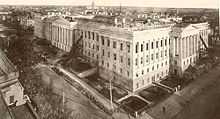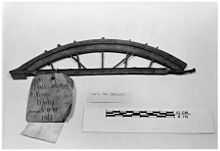1877 U.S. Patent Office fire
 Patent Office 1877 fire woodcut published in Harper's Weekly 13 October 1877 after Timothy H. O'Sullivan photograph | |
| Date | 24 September 1877 |
|---|---|
| Location |
U.S. Patent Office, Washington, D.C., USA |
| Coordinates | 38°53′52″N 77°01′23″W / 38.89778°N 77.022936°W |
| Outcome |
Entire west and north wing of Patent Office building burnt. |




Patent Office examiners at work.
Said to be "riding the patent office pony"

The Patent Office fire of 1877 was the second of several disastrous fires in the history of the U.S. Patent Office. It occurred in the Old Patent Office Building in Washington, D.C., on 27 September 1877. Although the building was constructed to be fireproof, many of its contents were not; some 80,000 models and some 600,000 copy drawings were destroyed. No patents were completely lost, however, and the Patent Office soon reopened.
History
On 4 July 1836, the Patent Office became a separate organization within the Department of State under the Patent Act of 1836 (5 Stat. 117). Henry Leavitt Ellsworth became its first commissioner. He immediately began construction of a new "fire-proof" building,[1][2] which was not completed until 1864.[3][upper-alpha 1]
The Patent Office fire started at about 11 am on 24 September 1877. American author Bret Harte reports in The writings of Bret Harte that it was not known when or where the fire started.[upper-alpha 2] There have been guesses as to what started the fire, as the exact cause was never conclusively determined. One guess is that it was spontaneous combustion from chemical fumes in the upper part of one of the wings, as fumes collected there in condensed amounts, making it a potential fire hazard. There was a considerable amount of flammable material in that area and the roof was constructed of wood, which led to a rapid ignition and a fast-moving and disastrous building fire. The fire burned part of the upper portions of the north and west wings.[4] Another theory was that a lens might have caught the sun's rays and focused them on a combustible object.[5]
Others claim that it was an "unseasonably chilly" morning, and that a fire started by some copyists in their office grate emitted sparks that landed on the roof, igniting a wooden gutter screen. Before long, seemingly half the building was in flames. "The scene was one of awful grandeur," reported the Evening Star. Despite architect Robert Mills' best efforts, fire proofing was imperfect.[upper-alpha 3] "Ironically, although Mills' successor as architect, Thomas U. Walter, had been one of the harshest critics, claiming that Mills' vaulted ceilings would collapse in the event of fire, the conflagration actually consumed much of Walter's shallower, iron-reinforced vaulting, and left the earlier ceilings intact."[6]
Models destroyed
This second Patent Office fire was even more destructive than the first fire in 1836 at Blodget's Hotel. According to the Superintendent of Models, some 80,000 models and some 600,000 photolithographic copies of drawings were ruined.[3][7] Additionally, there were some 37,000 postponed and 12,000 rejected cases,[upper-alpha 4] making the damage tally about 136,000 patent models (of one type or another). This "fire proof" building cost almost $3,000,000 in nineteenth century dollars.[8] Another source reports an additional loss of over a half a million dollars in cash.[9]
Although the building may have been considered fire-proof, "the contents were not."[2] An early part of the conflagration was a storage room used for rejected models, which may have totalled approximately 20,000 in number. While the patent office could loan those out to museums and other organizations, the increase in litigation made their preservation important and militated against such transfers. Contemporaneous reports state that in all between 65,000 and 80,000 models were damaged. These models included metal-working machines, wood-working machines, agricultural implements, carriages, wagons, railroading, mechanical, hydraulic and pneumatic engineering. A model of the original Eli Whitney cotton gin was among the models destroyed. In the south and west wings of the Patent Office there were some 100,000 models that were not damaged. Reports of the time show about two-fifths of all the models were damaged either by fire or water. An estimated 200,000 drawings were hastily carried out of the building before they were damaged.[5]
In spite of these great monetary losses (many times those of the first Patent Office fire of 1836), there were no patents totally lost in the fire.[10][upper-alpha 5] There were duplicates of the drawings (a lesson learned from the first Patent Office fire in 1836) and it was just a matter of the expense of printing them again.[11] Despite the loss of the upper floors and some accumulated "rubbish," the Patent Office was soon reopened.[4]
See also
- 1836 U.S. Patent Office fire
- 1973 National Archives Fire (Similar fire at US National Archives records center.)
Bibliography
Footnotes
- ↑ The following year, 1865, it was the venue for Abraham Lincoln's Second Inaugural Ball, the first ball held in a government building; twelve years later it had its own fire. See Goodheart, p. 4
- ↑ Harte, Bret (1914). The writings of Bret Harte. Houghton Mifflin. p. 237. Retrieved 19 December 2011. Although the government spent four hundred dollars a week for watchmen, nobody knew just when and where the fire started, and it had made great headway before the firemen arrived.
- ↑ Mills was an early advocate of buildings designed to include fireproof materials. For example, the Fireproof Building, originally called the Charleston District Record Building {It is now believed to be the oldest building of fireproof construction in the United States.} was the earliest building of its type, and far exceeded the prevalent technology in 1827. "Fireproof Building". National Park Service. Retrieved 31 December 2011. A fire in Kingstree, South Carolina destroyed much of the upper floor of the courthouse called the "Fireproof Building" which had been designed by Mills, but the county records on the first floor were protected due to his fireproofing measures. A fire also destroyed much of the Lancaster County, South Carolina Courthouse in August 2008.
- ↑ Brief History of the United States Patent Office from its foundation—1790 to 1886—with an outline of laws, growth, publications, office routine, etc. Washington, D.C.: R. Beresford, Printer. 1886. Retrieved 16 December 2011. The fire originated in the model room, where about 12,000 rejected models were stored...
- ↑ Dobyns, Kenneth W. "30: Sorting and Repairing Broken Patent Models". Patent Office Pony: History of the United States Patent Office. p. 192. Retrieved 21 December 2011. The monetary loss from the fire of 1877 was many times that of the 1836 fire, but the information loss was only partial. Models were lost in great number, but the drawings which corresponded to the models were unharmed. Some 600,000 photolithographed drawings were lost, but these were easily replaced at the minor expense of printing them again. Also lost were 300 original drawings which had already been printed. The major loss was of the drawings and the corresponding models for 31 older patents, leaving only the specifications from which to restore the patent. No patents were totally lost in the fire of 1877.
End notes
- ↑ Goodheart, Adam (July 2006). "Back To The Future: One of Washington's most exuberant monuments—the old Patent Office Building—gets the renovation it deserves". Smithsonian magazine. p. 3. Retrieved 21 December 2011.
- ↑ 2.0 2.1 "One Hot Commodity: Great Patent Fire of 1836 United States Patent Office". Kids pages. United States Patent and Trademark Office. Retrieved 16 December 2011.
- ↑ 3.0 3.1 Keim, DeB Randolph (November 1874). Keim's Illustrated Guide to the Museum of Models, Patent Office; containing a descriptive list of the Washington relics, and other objects of historical interest on exhibition, and of the contents of each case of models, together with a brief account of the most notable inventions. Washington, D.C. Retrieved 16 December 2011.
- ↑ 4.0 4.1 "Patent Materials from Scientific American, The Fire in the U.S. Patent Office". 37 new series - issue Jul 1877 – Dec 1877 (15). Scientific American. 13 October 1877. p. 224. Retrieved 21 December 2011.
- ↑ 5.0 5.1 "Patent-Office Fire". Harper's Weekly. 13 October 1877. pp. 809–810.
- ↑ Goodheart, Adam. p. 4.
- ↑ Campbell, Levin H. (1891). The Patent System of the United States so far as it relates to the Granting of Patents: A History. Washington D.C.: Press of McGill and Wallace. Retrieved 14 December 2011.
- ↑ Report of the investigation of the United States Patent office made by the President's commission on economy and efficiency. United States Printing Office. December 1912. pp. 131–132. Previous to the occurrence of the fire the Patent Office Building had been looked upon as a fireproof structure.
- ↑ Harte, p. 237
- ↑ Niemann, p. 130 The 1877 fire caused much more damage than the 1836 fire did, but no patents were lost this time because the office had begun the practice of making copies of each new patent filing.
- ↑ Dobyns, Kenneth W. (November 1994). "30 "The second Patent Office fire"". Patent Office Pony: History of the United States Patent Office (1st ed.). Sergeant Kirklands Museum. p. 184-192. ISBN 0-9632137-4-1. Retrieved 21 December 2011. ISBN 978-0-9632137-4-7
Sources
- Dobyns, Kenneth W. (November 1994). "30 "The second Patent Office fire"". Patent Office Pony: History of the United States Patent Office (1st ed.). Sergeant Kirklands Museum. p. 184-192. ISBN 0-9632137-4-1. Retrieved 21 December 2011. ISBN 978-0-9632137-4-7
- Goodheart, Adam (July 2006). "Back To The Future: One of Washington's most exuberant monuments—the old Patent Office Building—gets the renovation it deserves". Smithsonian magazine. pp. 40–47. Retrieved 20 December 2011.
- Harte, Bret (1914). The writings of Bret Harte. Houghton Mifflin. p. 237. Retrieved 19 December 2011. Downloadable copy at Internet Archive
- Keim, DeB Randolph (November 1874). Keim's Illustrated Guide to the Museum of Models, Patent Office; containing a descriptive list of the Washington relics, and other objects of historical interest on exhibition, and of the contents of each case of models, together with a brief account of the most notable inventions. Washington, D.C. Retrieved 16 December 2011.
- Niemann, Paul (2006). More Invention Mysteries: 52 Little-Known True Stories Behind Well-Known inventions. Quincy, IL: Horsefeathers Publishing Company. ISBN 0-9748041-1-8. ISBN 978-0-9748041-1-8.
- "One Hot Commodity: Great Patent Fire of 1836 United States Patent Office". Kids pages. United States Patent and Trademark Office. Retrieved 16 December 2011.
- "Patent-Office Fire". Harper's Weekly. 13 October 1877. pp. 809–810.
Further reading
- Bryan, John (26 November 2001). Robert Mills: America's First Architect. New York: Princeton Architectural Press. p. 330. ISBN 1-56898-296-8. ISBN 978-1-56898-296-0.
- Dobyns, Kenneth W. (November 1994). The Patent Office Pony: A History of the Early Patent Office (1st ed.). Fredericksburg, Virginia: Sergeant Kirkland's Museum and Historical Society. p. 249. ISBN 0-9632137-4-1. ISBN 978-0-9632137-4-7
- Mills, Robert; Liscombe, Rhodri Windsor (1994). Altogether American: Robert Mills, Architect and Engineer, 1781–1855 (Hardcover). New York: Oxford University Press. ISBN 0-19-508019-X.
External links
- Rothschild’s Petersen Patent Model Museum timeline
- L.E. Walker photographs of the 1877 U.S. Patent Officer Fire. Cowan’s Auctions
Coordinates: 38°53′52″N 77°01′23″W / 38.89778°N 77.02294°W